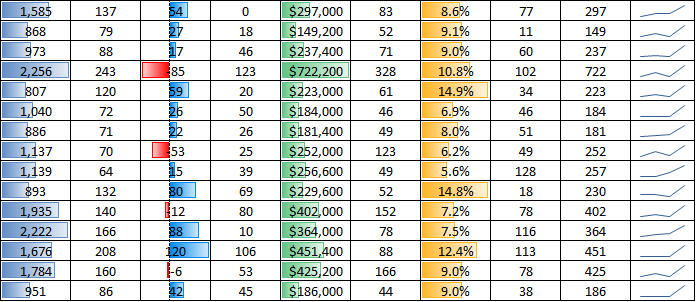Written by Webster Pacific Managing Partner Tom Paper. Published on Medium on April 18th, 2018.

I’ve hired and employed over 25 recent college grads since I graduated from Stanford Business School in 1990. The consulting practice, Webster Pacific, that my partner and I lead does strategy work that is highly data-intensive. We crunch massive amounts of data to answer our clients’ questions, many of which are in the K-12 private school business. The questions we answer include: Where should we open a new school? Where is the wealth in a market? Why are families leaving our school? How far do applicants typically live from our school? Why are teachers loyal to our school? To answer these questions, we analyze data…mountains of data. We currently employ six data analysts.
So here’s my advice to all recent grads interested in becoming a data analyst:
- Be impeccable. When you go through the drive-through at your favorite fast-food restaurant, you’d never be satisfied if they only got 4 out of 5 items right. So you shouldn’t accept anything less in your work. You need to adopt the attitude that you’re striving for perfection. There are a hundred different things in every analysis that can be wrong, so you’d better understand that your goal is nothing less than perfection. Your logic should be perfect; your formulas should be perfect; your presentation should be perfect…and I can guarantee you that you won’t achieve perfection, but if you too easily accept anything less, you will not be successful.
- Be iterative. You have to get stuff done, publish your analysis, get feedback and do it again. I call it going around the bases. The best investors are able to think about the numbers on a deal in a minute. Those numbers are the “deal model.” Over the weeks that an investor considers making an investment, they will have their data analysts iterate on that deal model, building up more and more analysis about each point in the deal model. My data analysts do the same kind of thing. There are three important subpoints to iteration: 1) Being iterative and being impeccable are NOT at odds. It’s true that “perfect is the enemy of the good” and that we have to get stuff done, but that doesn’t mean that we should compromise on our logic or on our formulas. Maybe the presentation isn’t perfect at first, but the basics of the logic and the formulas must be air-tight every time you iterate. 2) Stay current. Don’t be wedded to the past. You need to be prepared to change your analysis every time you iterate using the latest base data, strategic context and learning. 3) Compare your new iterations to your old iterations. If the new is different from the old, you must be able to explain that difference.
- Be paranoid. You’ve got to always be worried about how your analysis might be wrong. You have to double and triple-check your work and then ask yourself if your outputs make sense. I go over at least one analysis every day and every time I look at an analysis, I ask myself, “does this make sense?” I almost always start with the big picture or the universe. Has the data analyst shown me the big picture? Does it make sense? How has the big picture been broken up into smaller pieces? Does that make sense? If there’s a map and we’re working iteratively, how does the latest map compare to the previous map? Does that make sense? You can see how this goes. If anything doesn’t make sense, then I ask “Why?” Sometimes the explanations make sense, but often they don’t. Frankly, I get a little irritated when a data analyst offers an explanation, without supporting data, for why something doesn’t make sense to me. The data should do the talking, not the analyst. Most of the time when something doesn’t make sense, we have to look at more data to find the explanation and, in looking at the data, we either learn something or we find out that our logic or formulas were wrong.
- Be strategic. The data analyst will always be closest to the data and will understand all the details, but that doesn’t mean that he or she shouldn’t think about the big picture. Understanding the big picture depends upon understanding strategy. Every data analyst should read Michael Porter’s seminal article on strategy[1], which essentially says that strategy is the combination of market position and the activities taken in support of that position. The strategy of your organization is the ultimate context of your analysis. You need to understand how all the data you’re crunching fits in with that strategy.
- Be a geek. This may seem obvious, but there are some analysts who want to opine on the big picture and not dive into the details about how the software works. In my view, you’ve got to love the technology and, only then, will you drive yourself to understand all the wonky details about how your calculation process works. I’ve seen the “discovery” of more than one native feature in a complicated software product that changed the way that we do our analysis. Be curious; take chances; invest your time in learning. The future portends only more and more features.
- Fall in love with the insights, not the numbers. You’re paid to generate credible, data-driven insights. Don’t confuse quantity with quality. My biggest complaint with tools like Tableau is that they make it easy to generate mountains of graphs. That makes an analyst think that they’re doing a great job by generating a bunch of charts when all they’re doing is adding noise. You have to know your story and tell it in the simplest terms possible, while still having all the data necessary to answer questions.
- Be aggressive. Software goes at the speed of light. How fast does your brain go? Models can be gnarly and nuanced things. There can be dozens of calculations between fields and millions of records in a database. I’m counting on my analyst to ensure the soundness of the calculations, which means they have to repeatedly walk through those calculations in their minds. I once had a mild-mannered analyst who told me that he had recently reformed himself from his past, where he had gotten a speeding ticket for going 150 mph on a trip from SF to LA. I told him, “Hey, I’m happy for you to take that craving for speed out of your personal life, but at work I actually want to see that.”
- Be of service. I believe that we’re all here to be of service to others. A data analyst is no different. Who is your customer? How are you serving them? That’s the easy part. The hard part is really listening hard to what they say and adjusting your analysis after getting their feedback. Our team could not do the analysis we do without the feedback of our clients. They make us better. So service is not just delivering a valuable product; it’s doing the work, delivering it and then listening hard to feedback and adjusting and doing it again.
- Make Google your best friend. Google is a monumentally valuable resource and you need to learn how to reflexively use it. Never ask your boss a question that you could have Googled first. Never.
- Have fun. Think of your work as an adventure. It’s easy to get serious. It’s harder to keep a spirit of adventure about your work. There will always be challenges and each of those challenges are opportunities for adventure. The fun comes when you face a problem you don’t know how you will solve, but then you figure it out. You solve it and you learn.
